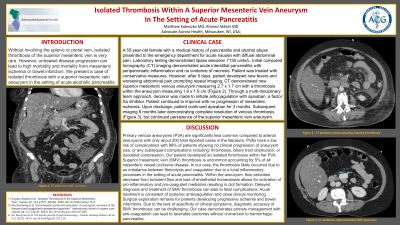Back


Poster Session D - Tuesday Morning
Category: Biliary/Pancreas
D0039 - Isolated Thrombosis Within a Superior Mesenteric Vein Aneurysm in the Setting of Acute Pancreatitis
Tuesday, October 25, 2022
10:00 AM – 12:00 PM ET
Location: Crown Ballroom

Has Audio

Matthew Kobeszko, MD, MBA, MS
Advocate Aurora Health
Milwaukee, WI
Presenting Author(s)
Matthew Kobeszko, MD, MBA, MS1, Ahmed Akhter, MD2
1Advocate Aurora Health, Milwaukee, WI; 2Aurora Health Care, Milwaukee, WI
Introduction: Without involving the splenic or portal vein, isolated thrombosis of the superior mesenteric vein is very rare. However, untreated disease progression can lead to high morbidity or mortality from mesenteric ischemia or bowel infarction. We present a case of isolated thrombosis with a superior mesenteric vein aneurysm in the setting of acute alcoholic pancreatitis.
Case Description/Methods: A 55-year-old female with a medical history of pancreatitis and alcohol abuse presented to the emergency department for acute nausea with diffuse abdominal pain. Laboratory testing demonstrated lipase elevation of 7130 units/L. Initial computed tomography (CT) imaging demonstrated acute interstitial pancreatitis with peripancreatic inflammation and no evidence of necrosis. Patient was treated with conservative measures. However, after 5 days, patient developed new fevers and worsening abdominal pain prompting repeat imaging. CT abdomen demonstrated a new superior mesenteric venous aneurysm measuring 2.7 x 1.7 cm with a thrombosis within the aneurysm measuring 1.6 x 1.9 cm. Through a multi-disciplinary team approach, a decision was made to initiate anticoagulation with apixaban. With continued conservative management, patient continued to improve with no progression of mesenteric ischemia. Upon discharge, patient continued apixaban for 3 months. Subsequent imaging 6 months later demonstrating complete resolution of the venous thrombosis and without recurrence.
Discussion: Primary venous aneurysms (PVA) are significantly less common compared to arterial aneurysms with only about 200 total reported cases in the literature. PVAs have a low risk of complications with 88% of patients showing no clinical progression of aneurysm size, or subsequent complications including: thrombosis, biliary tract obstruction, or duodenal compression. Our patient developed an isolated thrombosis within her PVA. Superior mesenteric vein (SMV) thrombosis is uncommon accounting for 5% of all mesenteric vessel occlusive disease. In our case, the thrombosis likely occurred due to an imbalance between fibrinolysis and coagulation due to local inflammatory processes. Delayed diagnosis and treatment of SMV thrombosis can lead to fatal complications. Acute treatment is consistent of systemic anticoagulation and close clinical monitoring. Surgical exploration remains for patients developing progressive ischemia and bowel infarctions. Due to the lack of specificity of clinical symptoms, diagnostic accuracy of SMV thrombosis can be challenging.
Disclosures:
Matthew Kobeszko, MD, MBA, MS1, Ahmed Akhter, MD2. D0039 - Isolated Thrombosis Within a Superior Mesenteric Vein Aneurysm in the Setting of Acute Pancreatitis, ACG 2022 Annual Scientific Meeting Abstracts. Charlotte, NC: American College of Gastroenterology.
1Advocate Aurora Health, Milwaukee, WI; 2Aurora Health Care, Milwaukee, WI
Introduction: Without involving the splenic or portal vein, isolated thrombosis of the superior mesenteric vein is very rare. However, untreated disease progression can lead to high morbidity or mortality from mesenteric ischemia or bowel infarction. We present a case of isolated thrombosis with a superior mesenteric vein aneurysm in the setting of acute alcoholic pancreatitis.
Case Description/Methods: A 55-year-old female with a medical history of pancreatitis and alcohol abuse presented to the emergency department for acute nausea with diffuse abdominal pain. Laboratory testing demonstrated lipase elevation of 7130 units/L. Initial computed tomography (CT) imaging demonstrated acute interstitial pancreatitis with peripancreatic inflammation and no evidence of necrosis. Patient was treated with conservative measures. However, after 5 days, patient developed new fevers and worsening abdominal pain prompting repeat imaging. CT abdomen demonstrated a new superior mesenteric venous aneurysm measuring 2.7 x 1.7 cm with a thrombosis within the aneurysm measuring 1.6 x 1.9 cm. Through a multi-disciplinary team approach, a decision was made to initiate anticoagulation with apixaban. With continued conservative management, patient continued to improve with no progression of mesenteric ischemia. Upon discharge, patient continued apixaban for 3 months. Subsequent imaging 6 months later demonstrating complete resolution of the venous thrombosis and without recurrence.
Discussion: Primary venous aneurysms (PVA) are significantly less common compared to arterial aneurysms with only about 200 total reported cases in the literature. PVAs have a low risk of complications with 88% of patients showing no clinical progression of aneurysm size, or subsequent complications including: thrombosis, biliary tract obstruction, or duodenal compression. Our patient developed an isolated thrombosis within her PVA. Superior mesenteric vein (SMV) thrombosis is uncommon accounting for 5% of all mesenteric vessel occlusive disease. In our case, the thrombosis likely occurred due to an imbalance between fibrinolysis and coagulation due to local inflammatory processes. Delayed diagnosis and treatment of SMV thrombosis can lead to fatal complications. Acute treatment is consistent of systemic anticoagulation and close clinical monitoring. Surgical exploration remains for patients developing progressive ischemia and bowel infarctions. Due to the lack of specificity of clinical symptoms, diagnostic accuracy of SMV thrombosis can be challenging.
Disclosures:
Matthew Kobeszko indicated no relevant financial relationships.
Ahmed Akhter indicated no relevant financial relationships.
Matthew Kobeszko, MD, MBA, MS1, Ahmed Akhter, MD2. D0039 - Isolated Thrombosis Within a Superior Mesenteric Vein Aneurysm in the Setting of Acute Pancreatitis, ACG 2022 Annual Scientific Meeting Abstracts. Charlotte, NC: American College of Gastroenterology.
